Update: 21 December 2024
LMOs, GMOs, and Glyphosate (a toxic antibiotic)
Author: Julie Casper, C. Ac.
All living things are unknowingly – or unwillingly – being exposed to ongoing experimental efforts of biotech corporations.
Biotechnology is a very new field. Much about the interaction of Living Modified Organisms (LMOs) with earth's inhabitants and ecosystems is unknown. Concerns about biotechnology include adverse effects on biological diversity and serious risks to human health.
LMOs are commonly known as GMOs. LMOs form the basis of a range of new products and agricultural commodities. Products that contain dead modified organisms (non-living GMO components) include vaccines, pharmaceutical drugs, food additives, and many processed, canned, and preserved foods. LMOs also exist in the corn and soybean derivatives used in many foods and nonfoods; cornstarch is used for cardboard and adhesives, fuel ethanol for gasoline, vitamins and yeast-based foods such as beer and bread. In Canada, the United States, and the United Kingdom, pre-harvest crop desiccation is being used on most conventional crops.
Contents
- Chronic Antibiotic Exposure
- Hundreds of Schools Next to Fields using Toxic Herbicides
- GMO Agriculture
- GMO Crops, Glyphosate and the Deterioration of Health
- GMO corn causes tumors, organ damage and premature death.
- Nutritional Implications of GMOs
- GMO versus non-GMO Corn, a Nutritional Analysis
- Comparison of GMO corn with non-GMO corn
- 15 Things the ‘Food’ Industry is Trying to Hide from You
- Resources
Chronic Antibiotic Exposure
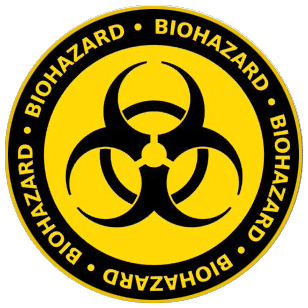
The initial patent for Glyphosate® was as a mineral chelater, Glyphosate was used to clean industrial pipes. The second patent was as an herbicide and third patent as an antibiotic. In 2000 Monsanto lost patent as herbicide so today over 750 formulations containing Glyphosate are in the market place from different chemical companies.
Monsanto still retains the patent for Glyphosate as an antibiotic. You may recognize it's commercial name, RoundUp®. Because of its widespread adaptation in modern industrial agriculture, it has become a significant source of chronic antibiotic exposure in our food supply. It also is implicated as a significant cause of newly emergent antibiotic resistant bacteria. And Dow AgroSciences herbicide Enlist Duo® combines glyphosate and 2-4D (Agent Orange), which will increase the toxicity of our environment and increase emergent antibiotic resistant bacteria.
- Glyphosate Changes Antibiotic Susceptibility [Report]
- Glyphosate-based Herbicides: Toxicity of formulations [Report]
Another notable source of chronic antibiotic exposure is our water supply. The agricultural runoff of glyphosate, 2-4D, medical antibiotics in the manure spread on fields (as much as 97% unmetabolized), and the unmetabolized antibiotics from human excretion, ultimately end up back in the water supply. Water treatment facilities are not equipped to remove these types of synthetic chemical compounds. The EPA standards for glyphosate in water in America is .7ppm. European research demonstrated organ damage to animals at .1ppb (.0001ppm) of glyphosate in water. U.S. water levels allow glyphosate at levels 7,000 times higher than what has been shown to be toxic in animals.
- Farmer's Footprint | Regeneration : The Beginning A hopeful 20 min. documentary. If you are in a hurry, skip ahead to 12:45 to see Dr Zach Bush explain scientific findings exposing why we face a chronic disease epidemic — and its connection to industrial agricultural.
Antibiotic literally means anti-life. It is a biocide. About 80% of all immunologically active cells are located in the gut-associated lymphoid tissue. Microbes in the gut are critical to immunological development. So it comes as no surprise that chronic antibiotic exposure would destroy the important bacteria in our gut, thus compromising immune function. The consequence is that almost everyone has underfunctioning immune and digestive systems. The health impact is catastrophic. Especially for children. In fact, a study published in Academic Pediatrics in 2011 estimated that 54% of American children have at least one diagnosed chronic illness. And autism spectrum disorders (ASD) are epidemic.
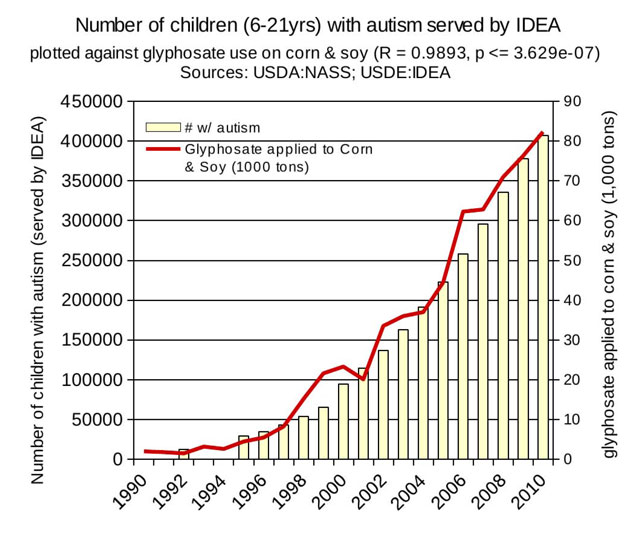
Correlation between children with autism and glyphosate applications. Increases in autism spectrum disorders (ASD) have been so great in recent years that most experts now agree that they are real and must be environmentally induced (Weintraub, 2011). This report found data for autism from the U.S. Department of Education, Individuals with Disabilities Education Act (USDE:IDEA) (Gallup, 2002; Snyder, 2012). These data are for autistic children 6-21 years old served under IDEA. In the plot in this graphic, the numbers for the year correspond to the beginning of the school year in the fall.
Back to Top
Download GMO Myths and Truths.
Hundreds of schools are located next to agricultural fields that spray highly-toxic herbicides.
The Environmental Working Group (EWG) has created an interactive map that shows the amounts of glyphosate sprayed in each U.S. county, and tallies the 3,247 elementary schools that are located within 1,000 feet of a corn or soybean field and the 487 schools that are within 200 feet. You can click any county on the map to see how much GMO corn and soy acreage has increased there as well as the number of nearby elementary schools.
The 15 states outlined on the map across the center of the country are the ones where the Environmental Protection Agency (EPA) has approved the use of Dow AgroSciences' Enlist Duo. Monsanto's Enlist Duo is a combination of glyphosate and 2,4-D (2,4-D was previously banned in the U.S.). Enlist Duo is used on GMO corn and soybeans that have been engineered to tolerate the highly toxic combination cocktail. Source: Alternet
Back to TopThe time has come to revisit the United States' reluctance to label GM foods. Labeling is essential for tracking the emergence of new food allergies, and for assessing health effects of the chemical herbicides that are applied to GM crops. A growing number of consumers insist they have a right to know what foods they are buying and how they were produced. The conventional argument that there is nothing new about genetic rearrangement misses the point that GM crops are now the agricultural products most heavily treated with herbicides, and two of these herbicides (glyphosate and 2,4-D) pose risks of cancer. We hope the FDA will reconsider the labeling of GM foods. GMOs, Herbicides, and Public Health, P. Landrigan, M.D., C. Benbrook, Ph.D.
GMO Agriculture
Conventional agriculture relies heavily on GMO crops engineered to withstand heavy use of glyphosate. GMO crops are commonly referred to as RoundUp® Ready. The cultivation of the these mainstream GMO crops requires more chemicals, not less. GMO crops have significantly less nutrition than non-GMO crops because glyphosate ties up soil nutrients and kills the beneficial microorganisms that make nutrients available to plants.
The USDA has been tracking the nutrient density of 43 crops for 60 years. USDA data shows a progressive, and alarming, rate of decline in nutrition since the "green revolution" began in the 1940's.
Glyphosate (Roundup®) is not just an herbicide. It was originally patented as a mineral chelator. It immobilizes nutrients, making them unavailable for your body. It's also patented as a potent antibiotic that can devastate human gut bacteria. The EPA recently doubled the amount of glyphosate allowed in food. Soybean oil is now allowed to contain a whopping 4,000 times the limit at which it can impact your health. Dr. Don Huber, Professor Emeritus of Plant Pathology, Perdue University
Dr. Huber has created an excellent presentation citing thousands of studies showing the dangerous health effects of the use of GMOs and glyphosate. As shown in the graphs below, GMO use has been positively correlated to the sudden rise in various diseases such as diabetes, autism, celiac disease, Alzheimer's, kidney disease, acute allergies, liver disease, as well as reproductive failures, miscarriages and birth defects.
GMO Crops, Glyphosate and the Deterioration of Health
A huge increase in the incidence and prevalence of chronic diseases has been reported in the US over the last 20 years. Similar increases have been seen globally. The herbicide glyphosate was introduced in 1974 and its use is accelerating with the advent of herbicide-tolerant genetically engineered (GE) crops. Evidence is mounting that glyphosate interferes with many metabolic processes in plants and animals and glyphosate residues have been detected in both. Glyphosate disrupts the endocrine system and the balance of gut bacteria, it damages DNA and is a driver of mutations that lead to cancer.
Rise in kidney failure / Rise in GMOs
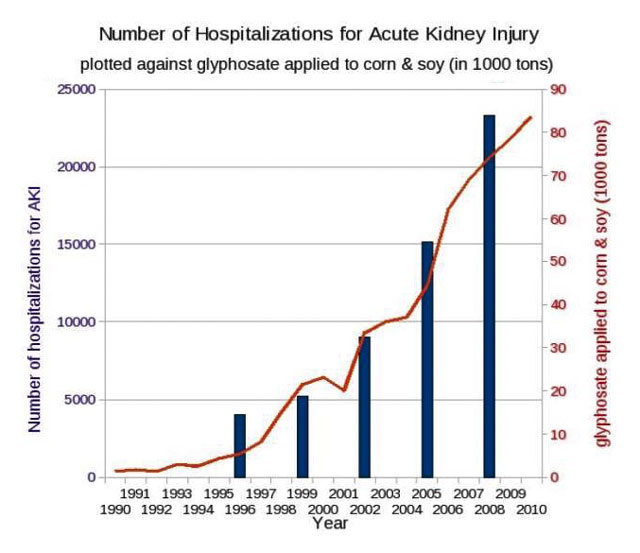
Deaths from Alzheimer's / Rise in GMOs
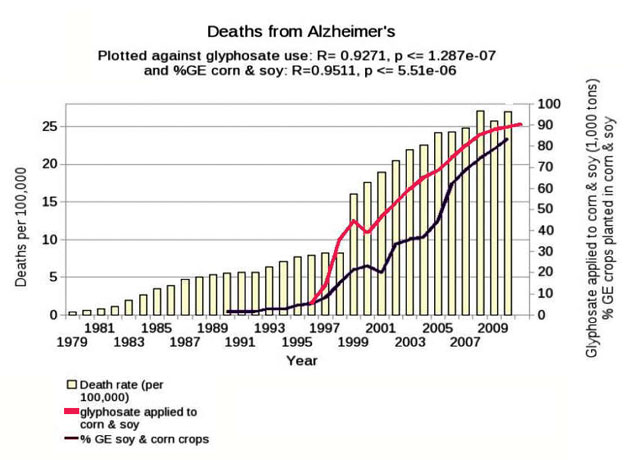
Some of the graphs in this report show a significant linear rise that began prior to 1990. Others show a peak in the 1980s, then a decline followed by another rise in the 1990s. Clearly, there are multiple factors involved. Though the data for glyphosate are only available beginning in 1990, glyphosate was first introduced in the marketplace in 1974. Other known endocrine Disruptors are: BPA (bisphenol-A) and phthalates (both in plastics), dioxins (by-product of smelting, paper bleaching, manufacture of herbicides and pesticides), hexane (cooking oil extraction), atrazine, and polychlorinated biphenyls (PCBs - used in electrical equipment, coatings, inks, adhesives, flame-retardants, and paints) (Kavlock, 1996).
The population of the US is bombarded with a veritable cocktail of chemicals daily in addition to GE food and glyphosate (Reuben, 2010). These include food preservatives (BHA & BHT), water contaminants (chlorine & fluoride), heavy metals, food additives (aspartame, monosodium glutamate, carrageenan) and food coloring, to name a few. The US President's Cancer Panel reported that a study by the CDC found many toxic chemicals in the blood and urine of most Americans that they tested, and the Environmental Working Group found up to 232 xenobiotic chemicals in the placental cord blood of newborns in the US (Reuben, 2010). The people have been exposed to an increasing background level of chemicals and other toxins for over 70 years, yet few, if any, have increased at the rate of glyphosate and GE crops.
Back to TopGMO corn causes tumors, organ damage and premature death.
A study led by Gilles-Eric Seralini of the University of Caen, examined the long-term (lifetime) effects of eating genetically modified organisms (GMOs). Unfortunately, no such studies were ever conducted before GMO corn was approved for widespread use by the USDA and FDA. In this regard, these agencies do not practice the simple "First Do No Harm" principle of mineral balancing.
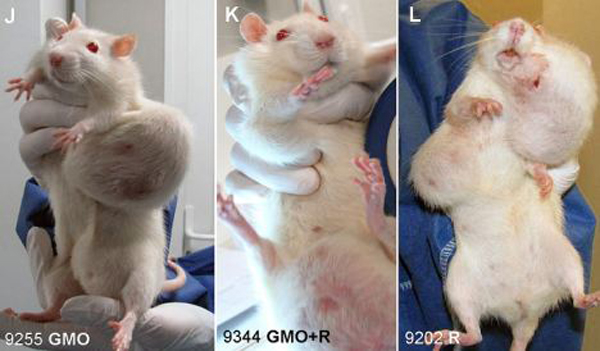
Images show tumors in mice caused by eating genetically modified (GM) corn.
The animals on the GMO diet suffered mammary tumors, as well as severe liver and kidney damage. The researchers said 50 percent of males and 70 percent of females died prematurely, compared with only 30 percent and 20 percent in the control group. Gilles-Eric Seralini
Key findings
- Up to 50% of males and 70% of females suffered premature death.
- Rats that drank trace amounts of Roundup (at levels legally allowed in the water supply) had a 200% to 300% increase in large tumors.
- Rats fed GM corn and traces of Roundup suffered severe organ damage including liver damage and kidney damage.
- The study fed these rats NK603, the Monsanto variety of GM corn that's grown across North America and widely fed to animals and humans. This is the same corn that's in your corn-based breakfast cereal, corn tortillas and corn snack chips.
Jose Bove, vice-chairman of the European Parliament's commission for agriculture and a fierce opponent of GMOs, called for an immediate suspension of all EU cultivation and import authorizations of GM crops.
This study finally shows we are right and that it is urgent to quickly review all GMO evaluation processes,’ he said in a statement. National and European food security agencies must carry out new studies financed by public funding to guarantee healthy food for European consumers.
All Americans can do is to try to avoid eating any GM foods, educate their friends and family, encourage lawmakers to develop and enforce legislation to protect health rather than ensure greater corporate profits. The food industry also needs to provide consumer's with complete information and accurate labeling.
Nutritional Implications of GMOs
‘While the debate on the safety of GMOs remains important, it should not distract from remediating the serious health risks of glyphosate sprayed on both RoundUp Ready and non engineered crops. After viewing this presentation many GMO videos may appear, but note that most avoid mentioning the herbicide, glyphosate, when more than 90% of all GMO crops in North America are sprayed with this herbicide that should have remained a pipe and boiler cleaner.’ — Theirry Vrain
Back to TopGMO versus non-GMO Corn, a Nutritional Analysis
New report demonstrates significant difference between the nutritional value of GMO corn and non-GMO corn. Not totally surprising because Glyphosate draws out the vital nutrients of living things and GMO corn is covered with it. The important thing to note in these deficiencies is that these are exactly the deficiencies in a human being that lead to susceptibility to sickness, disorders and cancer. People who have osteoporosis are low in calcium and magnesium, people who have cancer are low in manganese. The list goes on and on.
- GMO Corn has 14 ppm of Calcium and NON GMO corn has 6130 ppm. 437x more.
- GMO corn has 2 ppm of Magnesium and NON GMO corn has 113ppm. 56x more.
- GMO corn has 2 ppm of Manganese and NON GMO corn has 14ppm. 7x more.
Comparison of GMO corn with non-GMO corn
.jpg)
Note levels of Formaldehyde and Glyphosate in corn in the table above. The EPA standards for Glyphosate in water in America is .7ppm. European research demonstrated organ damage to animals at .1ppb (.0001ppm) of Glyphosate in water. U.S. water levels allow glyphosate 7,000X higher than what has been shown to be toxic in animals. As show above, corn has 13 ppm, this is 130,000 times higher than what is considered toxic to human health when found in water!
- Field comparison of GMO vs. non-GMO grown next to each other.
- GMO/Roundup Ready for ten year.
- No Roundup Ready on the crop/soil for five years.
- ERGS equals energy giving off per gram per second.
- Brix is a quality measurement. The higher the number the more nutrition, energy and protein in the feed sample.
 Back to Top
Back to Top
15 Things the ‘Food’ Industry is Trying to Hide from You
Since 2012, the agrichemical and food industries have mounted a complex, multifaceted public relations, advertising, lobbying and political campaign in the United States, costing more than $100 million, to defend genetically engineered food and crops and the pesticides that accompany them. The purpose of this campaign is to deceive the public, to deflect efforts to win the right to know what is in our food via labeling that is already required in 64 countries, and ultimately, to extend their profit stream for as long as possible.
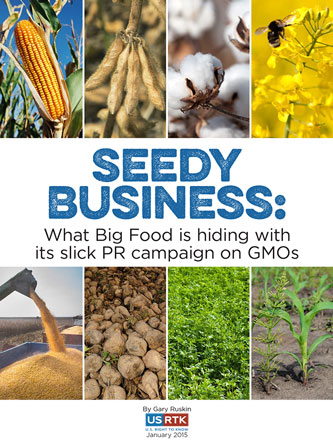
A report on the strategic campaign to defend GMOs. [Download PDF]
- The agrichemical companies have a history of concealing health risks from the public. Time and again, the companies that produce GMOs have hidden from consumers and workers the truth about the dangers of their products and operations. So how can we trust them to tell us the truth about their GMOs?
- The FDA does not test whether GMOs are safe. It merely reviews information submitted by the agrichemical companies.
- Our nation's lax policy on GMOs is the work of former Vice President Dan Quayle's anti-regulatory crusade. It was designed and delivered as a political favor to Monsanto.
- What the agrichemical and tobacco industries have in common: PR firms, operatives, tactics. The agrichemical industry's recent PR campaign is similar in some ways to the most infamous industry PR campaign ever – the tobacco industry's effort to evade responsibility for the deaths of hundreds of thousands of Americans each year.
- Russia's PR firm runs the agrichemical industry's big PR salvo on GMOs. We don't trust the PR firm Ketchum when it spins for Russia and President Putin. Why should we trust its spin on GMOs?
- The agrichemical industry's key front groups and shills aren't trustworthy. Many of the industry's leading advocates have records of defending the indefensible, or other scandals and conduct that inspires no confidence.
- The agrichemical companies have employed repugnant PR tactics. These tactics include attacks on scientists and journalists, and brainwashing children.
- The agrichemical companies have a potent, sleazy political machine. They have allies in high places, and employ their power vigorously – and sometimes corruptly — to protect and expand their markets and their profits from GMOs.
- Half of the Big Six agrichemical firms can't even grow their GMOs in their own home countries. Because of the health and environmental risks of GMOs, citizens of Germany and Switzerland won't allow farming of BASF, Bayer and Syngenta's GMO seeds.
- Monsanto supported GMO labeling in the UK but opposes it in the USA. Although Monsanto is based in St. Louis, Missouri, Monsanto believes that British citizens deserve stronger consumer rights than Americans do.
- The pesticide treadmill breeds profits, so it will likely intensify. It is in the financial interest of the agrichemical companies to promote the evolution and spread of the most pestilential superweeds and superpests, because these will spur the sale of the greatest quantities of the most expensive pesticides.
- GMO science is for sale. Science can be swayed, bought or biased by the agrichemical industry in many ways, such as suppressing adverse findings, harming the careers of scientists who produce such findings, controlling the funding that shapes what research is conducted, the lack of independent U.S.-based testing of health and environmental risks of GMOs, and tainting scientific reviews of GMOs by conflicts of interest.
- There are nearly no consumer benefits of GMOs. The GMOs that Americans eat are not healthier, safer or more nutritious than conventional foods. They do not look better, nor do they taste better. By any measure that consumers actually care about, they are not in any way an improvement. Profits from GMOs accrue to the agrichemical companies, while health risks are borne by consumers.
- The FDA and food companies have been wrong before: they have assured us of the safety of products that were not safe. Many drugs and food additives that the FDA allowed on the market have subsequently been banned because they were toxic or dangerous.
- A few other things the agrichemical industry doesn't want you to know about them: crimes, scandals and other wrongdoing. The agrichemical industry's six major firms — Monsanto, Syngenta, Dow, DuPont, Bayer and BASF — have been involved in so many reprehensible activities that documenting them would require at least an entire book.
Resources
Download
- Frontiers in Genetics: Glyphosate can Trigger Aggressive Breast Cancer Sept.2019, doi: 10.3389/fgene.2019.00885
- Health Effects Across Generations (from popular weed killer) Reports 'dramatic increase' in disease.
- The Monsanto Bayer Merger Why You Should Care
- The Monsanto Papers Collection of Monsanto Secret Documents.
- Glyphosate-based Herbicides: Toxicity of formulations
What's at Stake. First independent FDA-registered laboratory testing results for glyphosate found in food finds alarming harmful levels of contamination. Report also reveals inadequacy of U.S. food safety regulations for allowable pesticide residues. GLYPHOSATE: Unsafe on Any Plate
- Spinning Food Friends of the Earth
- Carcinogenicity of Glyphosate The International Agency for Research on Cancer (IARC)
- Glyphosate - Damage from Low-dose Exposure Environmental Health Journal
- Detection of Glyphosate in Malformed Piglets
- Glyphosate Report (monograph) Pesticide Action Network (PAN) - Prepared by Drs Meriel Watts, Peter Clausing, Angeliki Lyssimachou, Gesine Schutte, Rina Guadagnini, and Emily Marquez
Book
- The Road Back to Nature: Regaining the Paradise Lost by Masanobu Fukuoka
- Altered Genes, Twisted Truth Steven M. Druker
Video
- GMO Right to Know - PSA
- GMO OMG Documentary
- Genetically Modified Organism (GMO) - Myths and Truths
- Tips for Avoiding GMOs Natural Society
- Roundup Ready GMOs (pathogen new to science) Don Huber
- The World According to Monsanto
- Food Democracy Now YouTube channel
- Billions Go Hungry Because of GMO Farming Vandana Shiva
Article
- Glyphosate can trigger aggressive breast cancer when combined with another risk factor GM watch.org
- Monsanto Ordered to Pay $2 Billion to Cancer Victims
- Herbicide for Dinner
Chances are, most of what you ate today was harvested using a desiccant. Farmers desiccate by applying herbicide to their crops; this kills all the plants at the same time, making them uniformly dry and easier to cut. In essence, desiccation speeds up plant aging. Before desiccation, crops would have to dry out naturally at the end of the season. Today, almost all conventional crops are desiccated in Canada, the United States, and the United Kingdom.
- MONSANTO Preharvest Desiccation Guide (official propaganda) "...we produce this guide to help you get the most out of our herbicides."
- Jane Goodall and Steven Druker Expose US Government Fraud over GMOs
- One in every two children in the United States will be autistic by 2025
- Mom's Across America Anti-GMO Advocates
- Retracted Scientific Study On GMO Rats REPUBLISHED!
- Biofarms to Integrate Vaccines, Pharmaceuticals into GMO Biopharmaceutical Crops
- Side effects of GMOs
- Implications for GMO-cultivation and monitoring Environmental Sciences Europe (ESEU)
- Nature and Science magazines refuse to publish Dr. Bronner's anti-GMO advertisement
Website
- Non GMO Project
- Global Glyphosate Study initial research indicates adverse health effects at exposure levels specified "safe" by U.S. EPA regulating agency.
- Alliance for Bio-Integrity Jeffrey Smith
- The Institute for Responsible Technology (IRT)
- Seeds of Deception Jeffrey Smith
- Altered Genes, Twisted Truth How the Venture to Genetically Engineer Our Food Has Subverted Science, Corrupted Government, and Systematically Deceived the Public
- Earth Open Source
- GMO FACT CHECK Alliance for Natural Health USA
- Food Democracy Now
- https://www.saynotogmos.org/
- 10 Reasons to Avoid GMOs
- Seedy Business: What Big Food is Hiding with its Slick PR Campaign on GMOs U.S. Right to Know
- U.S. Right to Know
- UCSF Library (University of California San Francisco) Searchable archive of food industry documents which highlight serious problems in manufacturing, operations, regulatory activities, and scientific research. Including GMOs.
- Convention on Biological Diversity